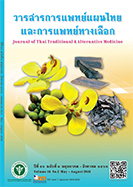Oxygen Consumption and Metabolic Equivalents during Ruesi-Dudton-Stretching Exercise in Healthy Females
Main Article Content
Abstract
The purpose of this study was to investigate the oxygen uptake response and metabolic equivalents (METs, or energy consumption rates)) during Ruesi Dadton stretching exercise in 30 healthy female volunteers (mean age, 20.0 ± 0.9 yrs). After determining the peak oxygen uptake (VO2peak) with a ramp incremental cycling test, each participant underwent Ruesi Dadton stretching exercise (15 postures, 5 times per posture), and before as well as during exercise, his/her oxygen uptake was measured using Cortex Biophysik, Metalyzer. The oxygen uptake rate and MET were calculated for each posture; and a blood sample from the fingertip was collected and analyzed to determine the blood lactate level over the last 20 s of baseline and within 20 s of the termination of exercise. The results demonstrated that there was a significantly increased oxygen uptake during the stretching exercise (ranging from 31.1±7.5 to 58.5±18.2% of VO2peak), compared to the resting period (26.2±6.4% of VO2peak) (p<0.05). In addition, METs significantly increased during the stretching exercise (ranging from 1.8±0.4 to 3.1±0.9), compared to the resting period (1.4±0.3, p<0.05). There was a significant difference between baseline and after exercise blood lactate levels (2.2±0.3 vs 4.3±1.8 mmol/l) (p<0.05). These findings reveal that Ruesi Dadton stretching exercise meets the requirements for an exercise of light-to-moderate intensity.
Article Details
References
of Printing Mill, The War Veterans Organization of Thailand; 1999. 64 p. (in Thai)
2. Benjamongkonwari P. Twenty-one self-stretching exercise postures (21 tha dadton). Bangkok: Moh-Chao-
Ban Publishing House; 2000. 64 p. (in Thai)
3. Lertsinthai P, Chidnok W. The effects of Ruesi Dadton stretching exercise on balance performance and hiptrunk
flexibility in healthy female students of Naresuan University. Thai Physical Therapy Journal 2005;27(3):52-71. (in Thai)
4. Chidnok W, Weerapun O, Wasuntarawat C, Lertsinthai P, Sripariwuth E. Effect of Ruesi Dadton stretching
exercise on respiratory muscle strength in females. Naresuan University Journal. 2007;29(3):127-136. (in Thai)
5. Chidnok W, Weerapun O, Wasuntarawat C, Lertsinthai P, Sripariwuth E. Effect of Ruesi Dadton stretching
exercise on anaerobic fitness exercise in healthy sedentary females. Naresuan University Journal. 2007;15(3):205-14. (in Thai)
6. Chidnok W, Weerapun O, Wasuntarawat C, Khamchon N, Duangneth D. Ventilatory and heart rate responses
during Ruesi Dadton stretching exercise. Thai Physical Therapy Journal. 2009;31(3):105-11. (in Thai)
7. American College of Sport Medicine. ACSMûs guidelines for exercise testing and prescription. 9th ed. Lippincott
Williams & Wilkins; 2014. 456 p.
8. William DM, Frank IK, Victor LK. Exercise physiology. Philadelphia (PA): Lippincott Williams & Wilkins;
2010:749-78.
9. Department for Development of Thai Traditional and Alternative Medicine. The Ministry of Public Health
encourages Thais to practise 15 postures of Ruesi Dadton stretching exercise. [Internet]. 2013; [updated 2013 April 25; cited 2016 March 31]. Available from: http://www.dtam.moph.go.th/index.php?option=com_content&view=article&id=282:pr0142&catid=8& Itemid=114. (in Thai)
10. Phra Chetupon Vimolmangklararm Temple. Ruesi dadton posture of contorting Thai traditional medicine
[cited 2016 March 31]. Available from: http://www. watpho.com/contorted_hermit_exercise.php (in Thai)
11. Chidnok W. Ruesi Dudton stretching exercise. J Med Tech Phy Ther. 2007;21(3):189-97. (in Thai)
12. Powers SK, Howley ET. Exercise Physiology: theory and application to fitness and performance. 8th ed. McGraw-Hill; 2012. 587 p.
13. William DM, Frank IK, Victor LK. Essentials of exercise physiology. Philadelphia (PA): Lippincott Williams & Wilkins; 2016.
14. Walter RT,Neil FG, Linda SP. ACSMûs Guidelines for Exercise Testing and Prescription. Philadelphia (PA):
Lippincott Williams & Wilkins;2010.


